Author: Vincent
Preface
Last year's Telegram (TG) trading bot and this year's popular Tap to earn game all point to an increasingly important target in the crypto world - TON.
And today! TON is finally listed on Binance~
Binance will list Toncoin (TON) on 2024-08-08 10:00 (UTC+8) and open trading for the following spot trading pairs:
New spot trading pairs: TON/BTC, TON/USDT, TON/FDUSD, and TON/TRY.
Users can now start depositing TON in preparation for trading.
Withdrawals will be open at 2024-08-09 10:00 (UTC).
Listing fee for TON: 0 BNB.
Toncoin network browsers: tonviewer.com, tonscan.org, tonscan.com
With 1 billion users, friendly crypto access, and a global potential market… numerous reasons make the TON ecosystem gradually become an indispensable and important part of the Crypto field.
Of course, the fundamental reason for everyone's attention may be the previous surge of NOT, DOGS, Hamster Kombat, and the large user base of Catizen. So, for builders who want to do projects in the crypto world, is this an opportunity?
The person in charge of TON's gaming ecosystem pointed out that currently about 20% of Telegram users are experiencing the game. With nearly 1 billion Tel global users, if calculated at a 20% rate, that would be 200 million users playing games through TEL, which is still a large volume, with unlimited future potential, this is just the beginning.
It is worth mentioning that the current gaming trend in the TON ecosystem reminds people of the past WeChat mini-programs. Chinese developers, take a look at the current Catizen, this Pinduoduo-style roulette, friend recommendations, do you smell a familiar taste?
Regarding articles about the TON ecosystem, Greythorn Asset Management did a detailed analysis in April this year, quoting: "TON Research Report: Ecosystem Exploration, Unique Performance, and Potential Opportunities"
Four months have passed, and the TON ecosystem has also developed a lot. Friends, remember to update your knowledge base.
Today, the main purpose is to sort out the current ecological situation and provide basic guidance for those who want to develop projects in the TON ecosystem. First, let's start with a mind map:
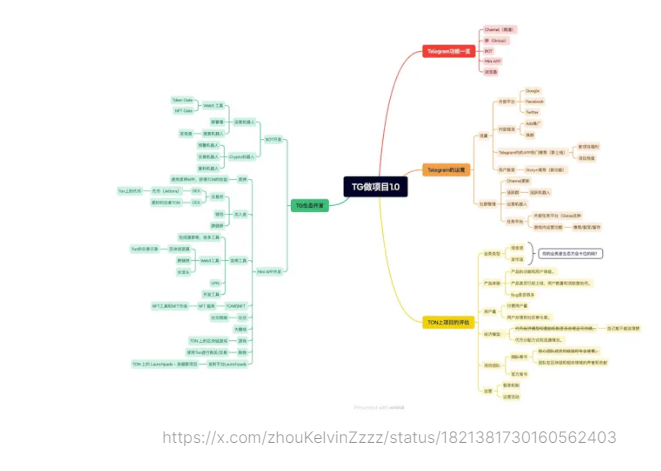
All projects mentioned in this article are used for case analysis and testing, and do not constitute any investment advice.
Next is the specific analysis.
1. Overview of Telegram Features
1.1. Channel
A Channel is a broadcasting tool on Telegram that allows administrators to send messages to a large number of subscribers. Channels have no limit on the number of subscribers, can be public or private, and can set administrator permissions to help manage content distribution.
1.2. Group
Groups are the main way for Telegram users to interact. Groups can accommodate up to 200,000 members and are an ideal platform for users to discuss, share information, and collaborate. Administrators can set different permissions, use fixed links to invite new members, and enhance group functionality through various bots.
1.3. BOT
Bots are automated tools in Telegram that can perform various tasks such as information dissemination, user interaction, and data collection. Bots can be used for customer service, games, trading, and community management. Developers can use Telegram's API to create and customize their own bots to meet specific needs.
1.4. Mini APP
Mini APPs are lightweight applications embedded within Telegram that users can use directly in chats. Mini APPs include wallets, small games, and utility applications, which can be accessed through bots or direct links, providing users with convenient and fast services.
1.5. Browser (New Feature)
Telegram's built-in browser allows users to open and browse web pages within the app without switching to an external browser. And in the version updated at the end of last month, users can fold the pages opened using the in-app browser and reopen them from the bottom bar, allowing them to freely move between messages and websites, instantly view articles and mini-apps.
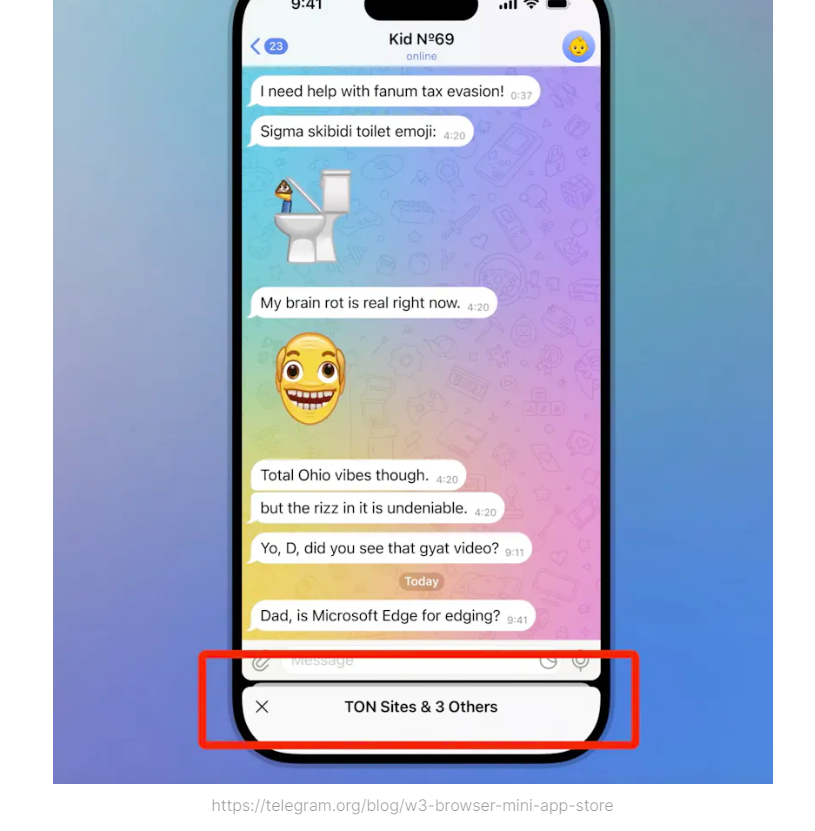
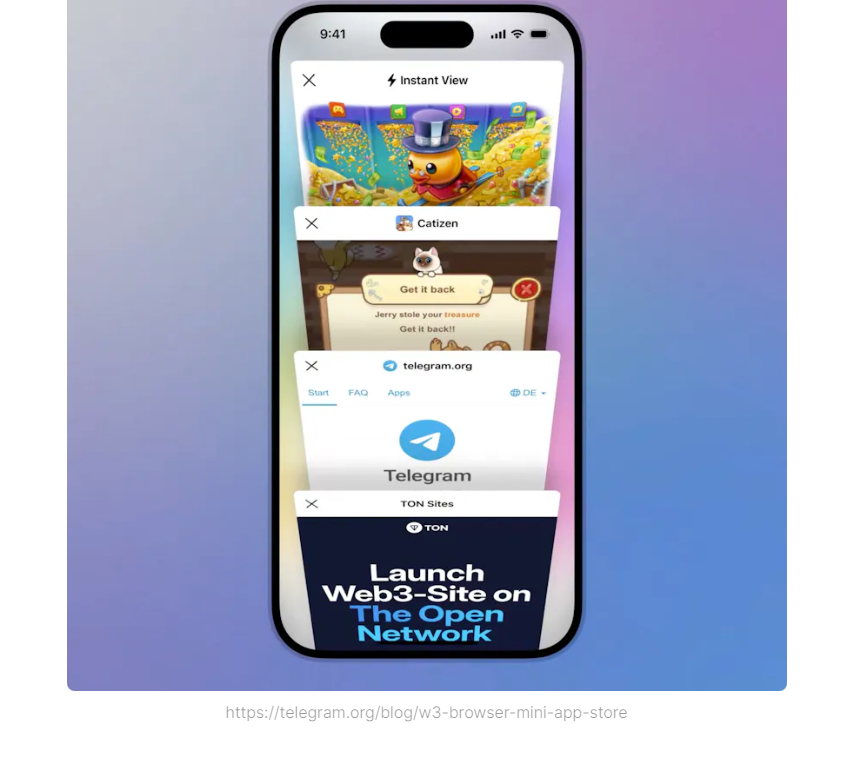
2. Some Concept Definitions
Telegram or TON
The author believes that Telegram and TON are deeply connected but also have their differences. Currently, TON can be seen as the core part of the Telegram ecosystem, providing web3 infrastructure support for all DApp developers on Telegram.
Specifically, in terms of definitions:
Telegram is a widely used instant messaging application known for its strong encryption and flexible development platform.
The Open Network (TON) is a blockchain project previously launched by the Telegram team, aiming to create a fast, decentralized network. TON aims to provide secure, fast payment solutions and support decentralized applications (dApps). Its features include high throughput, low latency, and a user-friendly development environment, attracting a lot of attention from developers and projects.
So, what are the differences?
For example, can trading bots developed on Telegram connect to ETH/SOL addresses? The answer is yes.
So, for a project that is a Telegram BOT or Mini APP, it seems that it doesn't have to be tied to the TON blockchain.
BOT or Mini APP
In fact, both BOT and Mini APP add more functions to the Telegram platform based on communication. From a product perspective:
BOT has more limitations for complex functions as it directly involves information interaction, but it does not require pop-up windows and can be operated through buttons and Q&A, making the interaction smoother.
Mini APP has more gameplay options and can be embedded in Telegram in the form of H5 pages (which reminds people of WeChat mini-programs). However, this also means higher user experience requirements, such as stronger perception of being stuck and higher visual design requirements.
3. Telegram Operations
3.1. Traffic
1. External Platforms
Google: Attract users to visit and download Telegram through Google Ads and SEO optimization.
Facebook: Use Facebook ads and page promotion to attract potential users.
Twitter: Attract users through promoted tweets and social interactions on Twitter.
This part of traffic promotion is quite traditional, but since it involves importing users from external platforms to Telegram, it is important to consider that it's best if your users already have a Telegram account, otherwise the churn rate is hard to imagine.
At the same time, the next question is, where should you spend this part of the budget? It should align with Telegram's user base.
Which regions have more Telegram users?
Which regions already have a habit of playing games on Telegram?
Which users are more willing to pay on Telegram?
Based on your project, you can benchmark competitors and carefully analyze these factors.
2. Internal Traffic Promotion
Ads Promotion: Use Telegram's internal advertising system to promote channels, groups, and BOTs to target users.
Group Exchange: Increase the exposure and membership of groups and channels through mutual recommendations and group exchanges.
This part is aimed at existing Telegram users. Ads promotion is paid for in TON, which is also an important integration point. When it comes to Ads, it's similar to Google Ads and you need to consider factors such as keywords, review times, and whether the groups you target have active members.
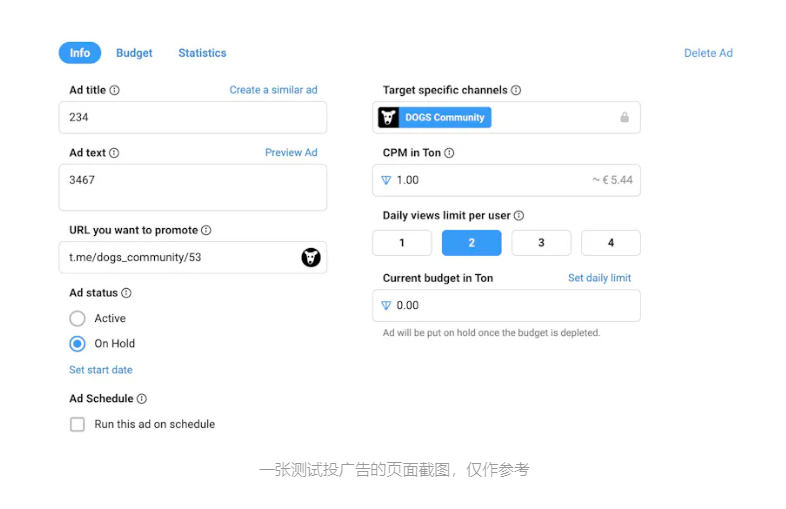
3. Built-in Popular Recommendations
Telegram has a built-in popular recommendation feature, recommending high-quality channels and groups to users.
Although there is no official explanation, the community has summarized some factors that make it easier to be recommended:
New projects are easier to be recommended, equivalent to receiving support.
Projects with high popularity, it seems that it's not purely based on user numbers, there may be other considerations.
Total number of stars paid by users.
In June this year, Telegram CEO Pavel Durov announced the launch of Telegram Stars, a new in-app token that can be used to purchase digital goods and services on the platform.
With Telegram Stars, Mini APPs can now accept payments for digital services in the simplest way—through in-app purchases on Android and iOS.
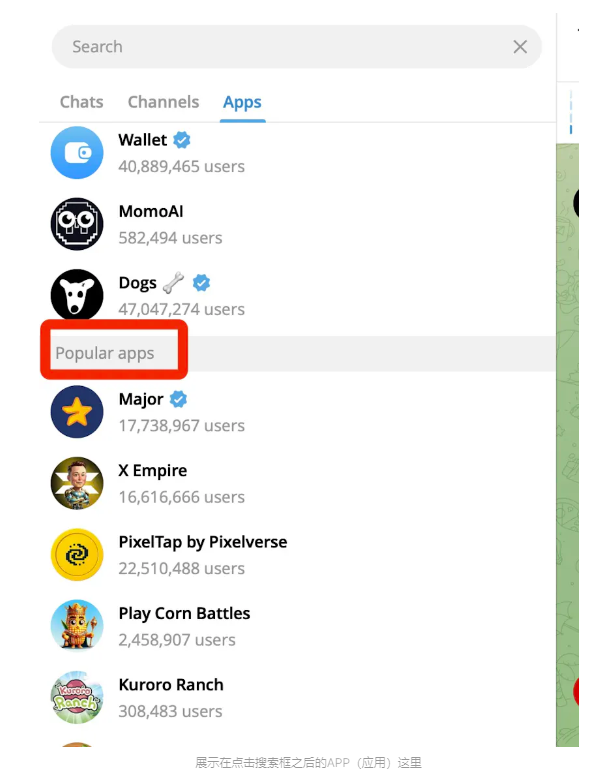
4. User Virality
Story+ Recommendations (New Feature): Users can quickly expand their social network within the platform by posting stories and recommending friends, increasing activity.
Personally, there are not many projects posting stories at the moment, but the push effect is good (probably because there are still relatively few people posting). I remember DOGS posted a story once, and if it hadn't, I probably wouldn't have gone back to check after receiving the airdrop.
I tried posting a story, and below is the display effect.
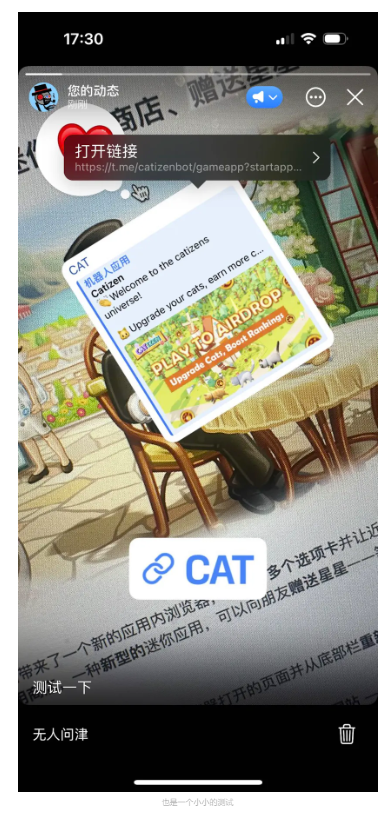
3.2. Community Management
1. Channel Updates
Regularly update channel content to ensure freshness and relevance, attracting and retaining subscribers' interest.
2. Active Groups
Maintain group activity through various activities and interactive content, such as Q&A, discussions, and sharing.
- Active Bots: Use bots to automate management tasks, increasing group interaction and convenience.
3. Operational Bots
Use bots to perform management tasks such as member review, message filtering, and activity notifications, improving management efficiency.
4. Task Platforms
External Task Platforms (Galxe): Use task systems provided by external platforms to increase user participation and activity.
In-game Operational Functions
- Recommendation/Virality/Retention: Embed recommendation and virality mechanisms in games to encourage users to invite friends, increasing user stickiness and retention. Catizen's big wheel really works well.
4. TG Ecosystem Development
Next, I will summarize some projects I have seen in TG, divided into BOT development and APP development.
4.1. BOT Development
Operational Bots
Web3 Tools
Token Gate: Provides access permissions for specific users.
NFT Gate: Provides permission control based on NFT holdings.
Group Management: Develop group management bots to automate daily management tasks. For example, group entry verification, spam message deletion, scheduled messaging, and scheduled member removal.
Search Bot: A bot that can automatically search and publish information.
Crypto Bots
Alert Bot: Provides market alerts and notification services.
Trading Bot: Automated trading tools to help users trade efficiently.
Arbitrage Bot: Automatically monitors and executes arbitrage trades to increase investment returns.
4.2. Mini APP Development
Here, you can see the specific categories of TON ecosystem projects. Official link
a. Staking
With staking apps, users can stake TON to earn rewards. These apps typically provide a simple staking process, display yield rates and earnings records, allowing users to easily manage their staked assets.
b. Deposit and Withdrawal
Exchanges
DEX
Token Trading (Jettons): Decentralized exchanges (DEX) developed on TON allow users to trade various tokens (Jettons). These platforms automatically execute trades through smart contracts, ensuring transparent and secure transactions.
CEX
Better TON Trading: Centralized exchanges (CEX) provide higher liquidity and more trading pairs, allowing users to conveniently trade TON and other cryptocurrencies on these platforms.
Wallets
Wallet apps allow users to securely store, send, and receive TON and other cryptocurrencies. Many wallets also offer integrated trading and staking services.
- Cross-chain Bridges
Cross-chain bridge apps enable users to transfer assets between different blockchains, facilitating cross-chain operations and increasing asset flexibility and liquidity.
c. Utility Tools
3.1. Search Tools, etc.
These tools provide convenient search functionality to help users quickly find the information they need.
Web3 Tools
- Block Explorer
Block explorers allow users to view transaction records and other related data on the TON blockchain, providing transparent and detailed on-chain information.
- Cross-chain Bridge
Cross-chain bridge tools enable users to transfer assets between different blockchains, increasing asset flexibility.
- Faucet
Faucet tools provide free TON or other cryptocurrencies, helping new users obtain initial funds to experience blockchain services.
d. VPN
VPN tools help users protect their privacy and ensure the security of their network connections, especially when using blockchain and cryptocurrency services.
e. Development Tools
These tools provide necessary resources and support for developers to help them develop and deploy applications on the TON platform.
f. TON NFT: NFT Services
- NFT Tools and NFT Market
These services provide tools and platforms for creating, managing, and trading NFTs. Users can buy and sell NFTs on these markets, participating in digital art and collectibles trading.
g. Social: Social Networks
Based on TON, social networking platforms allow users to establish and maintain social relationships, share content, and interact.
h. Casinos
Casino applications on the TON platform allow users to participate in various gambling and betting activities, typically providing a fair and transparent gaming environment.
i. Games: Blockchain Games on TON
These games provide unique gaming experiences using blockchain technology. Users can earn token rewards through games and use these tokens inside and outside the game.
The popular Tap to Earn series originates from this.
5. Evaluation of Projects on TON
This section reflects personal opinions and is open for discussion. Let's explore how projects on TON can thrive and consider potential development directions for project teams.
1. Business Type
Cash Flow: Evaluate whether the project has stable and continuous cash inflows. Cash flow projects are not much different from Web2 projects.
Token Issuance Flow: Analyze the project's token issuance and circulation situation (as well as the actual situation on the chain).
2. Product Experience
Product Functionality and User Experience: Evaluate the actual functionality and user experience of the product. Here, the focus is not on how good the technology is, but rather on ensuring basic functionality and the security of user assets.
Product Launch Status, User Count, and Activity: Understand the product's launch status and user activity to assess market acceptance.
Bug Count: Check the product's stability and the number of bugs. Projects that even make wallets lag may not have a chance to rug me, right?
3. User Base
Number of Paying Users: Focus on the number of paying users, an important indicator of the project's profitability.
User Feedback and Community Engagement: Evaluate the project's market recognition and user satisfaction through user feedback and community engagement.
4. Economic Model
Reasonableness and Sustainability of Token Economic Model and Incentive Mechanism: Ensure the reasonableness and sustainability of the token economic model and incentive mechanism.
- Clarity of Explanation: We certainly hope for innovative breakthroughs in the economic model, leading to a new wave of GameFi. However, we cannot be too demanding. But seeing many projects not considering the significance of token issuance, perhaps doing a cash flow project is also good; or simply issuing tokens to save on advertising costs. It's worth thinking more about whether such projects should be supported, so at least look at whether the project team can clearly explain its economic model.
Token Distribution and Circulation: Analyze the token distribution and market circulation to assess fairness and transparency (fear of being dumped by whales).
5. Project Team
Team Endorsement: Evaluate the experience and professional background of core team members, as well as the team's reputation and contributions in the blockchain and related fields.
This part is not too demanding, but the author will check whether the person has previous experience with rugs or soft rugs in projects.
Especially for some projects from 2021-2022, they made money and then did nothing, and now they are coming to TON to start over, which is worth deep consideration.
Official Endorsement: Check if authoritative institutions or well-known companies endorse and support the project.
6. Operational Strategies
Many projects may be planning to make some money first, which is certainly understandable. However, as a retail investor, should I invest? I don't want to be the last batch of retail investors to be rug pulled! We can look for some clues in their operations.
Virality Mechanism: Does the project have an effective virality mechanism to attract and retain users (is there anyone willing to take over)?
Operational Activities: Are regular operational activities conducted to increase the project's exposure and user engagement (indicating that they have strategies and plans)?
Conclusion
Currently, Telegram is continuously updating and optimizing, and it integrates with TON in many ways. The momentum is good, and the direction is very promising.
In the future, with the continuous advancement of technology and evolving user needs, we can expect more new features and optimizations to make the user experience smoother and richer. Whether for individual users, businesses, or community managers, they can find suitable tools and solutions on the Telegram platform to drive their own development and growth.
I welcome discussions and exploration of more possibilities and future development directions for Telegram. Looking forward to progressing together on this platform full of opportunities and innovation!
免责声明:本文章仅代表作者个人观点,不代表本平台的立场和观点。本文章仅供信息分享,不构成对任何人的任何投资建议。用户与作者之间的任何争议,与本平台无关。如网页中刊载的文章或图片涉及侵权,请提供相关的权利证明和身份证明发送邮件到support@aicoin.com,本平台相关工作人员将会进行核查。




